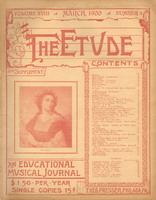In answer to many questions on the use of the vibrato, let me explain that the term vibrato implies a graceful and not too perceptible wave in the tone. It is imparted only to voices with a correct method of tone-production, and is explained thus: The column of air after having left the vocal cords, where it is converted into tone, receives its color character and quality from the shape of the hollow spaces by or through which it must pass. Some of these hollow spaces have flexible surfaces. Like the larynx, these loose or relaxed flexible surfaces yield to a demand for regular pulsations, and impart a delightful vibratory wave to the tone without in the least affecting its fundamental pitch. Thus, in voices well placed the vibration is just observable, while purity and pitch are unimpaired. The tremolo is altogether a different creation, the muscles contracting the vocal cords are held rigidly in their places by other muscles which have no normal vocal office to perform. The breath in such cases is controlled by these muscles instead of at the waist and when stress is applied the artificial conditions are indicated by the shudder or quiver of the organs in their effort to answer to the demands for tone. The result is disagreeable, the intonation is faulty, the voice struggles to give the pitch demanded, while the stiff muscles object, and the cry is havoc! Do not use the tremolo. Do not use the vibrato unless it is absolutely under control.



